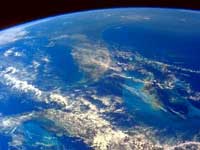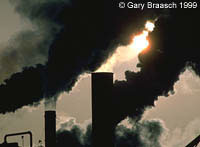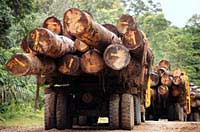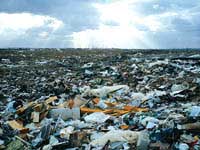If, in the 30 Earth Day celebrations we have held since 1970, the human population and economy have become any more respectful of the Earth, the Earth hasn’t noticed.

The planet is not impressed by fancy speeches. Leonardo DiCaprio interviewing Bill Clinton about global warming is not an Earth-shaking event. The Earth has no way of registering good intentions or future inventions or high hopes. It doesn’t even pay attention to dollars, which are, from a planet’s point of view, just a charming human invention. Planets measure only physical things — energy and materials and their flows into and out of the changing populations of living creatures.
What the Earth sees is that on the first Earth Day in 1970 there were 3.7 billion of those hyperactive critters called humans, and now there are over 6 billion. Back in 1970, those humans drew from the Earth’s crust 46 million barrels of oil every day — now they draw 78 million.
Natural gas extraction has nearly tripled in 30 years, from 34 trillion cubic feet per year to 95 trillion. We mined 2.2 billion metric tons of coal in 1970; this year, we’ll mine about 3.8 billion.

Fuelish frenzy.
The planet feels this fossil fuel use in many ways, as the fuels are extracted (and spilled) and shipped (and spilled) and refined (generating toxics) and burned into numerous pollutants, including carbon dioxide, which traps outgoing energy and warms things up. Despite global conferences and brave promises, what the Earth notices is that human carbon emissions have increased from 3.9 million metric tons in 1970 to an estimated 6.4 million this year.
You would think that an unimaginably huge thing like a planet would not notice the 1 degree Fahrenheit warming it has experienced since 1970. But on the scale of a whole planet, 1 degree is a big deal, especially since it is not spread evenly. The poles have warmed more than the equator, the winters more than the summers, the nights more than the days. That means that temperature differences from one place to another have been changing much more than the average temperature has changed. Temperature differences are what make winds blow, rains rain, ocean currents flow.
All creatures, including humans, are exquisitely attuned to the weather. All creatures, including us, are noticing weather weirdness and trying to adjust, by moving, by fruiting earlier or migrating later, by building up whatever protections are possible against flood and drought. The Earth is reacting to weather changes, too, shrinking glaciers, splitting off nation-sized chunks of Antarctic ice sheet, enhancing the cycles we call El Niño and La Niña.
“Earth Day, Shmearth Day,” the planet must be thinking as its fever mounts. “Are you folks ever going to take me seriously?”

Trees to the slaughter.
Since the first Earth Day, our global vehicle population has swelled from 246 million to 730 million. Air traffic has gone up by a factor of six. The rate at which we grind up trees to make paper has doubled (to 200 million metric tons per year). We coax from the soil, with the help of strange chemicals, 2.25 times as much wheat, 2.5 times as much corn, 2.2 times as much rice, almost twice as much sugar, and almost four times as many soybeans as we did 30 years ago. We pull from the oceans almost twice as much fish.
With the fish, we can see clearly how the planet behaves, when we push it too far. It does not feel sorry for us; it just follows its own rules. Fish become harder and harder to find. If they are caught before they’re old enough to reproduce, if their nursery habitat is destroyed, if we scoop up not only the cod, but the capelin upon which the cod feeds, the fish may never come back. The Earth does not care that we didn’t mean it, that we promise not to do it again, that we make nice gestures every Earth Day.

Climb every mountain (of trash).
We have among us die-hard optimists who will berate me for not reporting the good news since the last Earth Day. There is plenty of it, but it is mostly measured in human terms, not Earth terms. Average human life expectancy has risen since 1970 from 58 to 66 years. Gross world product has more than doubled, from 16 to 39 trillion dollars. Recycling has increased, but so has trash generation. The Earth receives more garbage than ever before. Wind and solar power generation have soared, but so have coal-fired, gas-fired, and nuclear power generation.
In human terms, there has been breathtaking progress. In 1970, there weren’t any cell phones or video players. There was no Internet; there were no dot-coms. Nor was anyone infected with AIDS, of course, nor did we have to worry about genetic engineering. Global spending on advertising was only one-third of what it is now (in inflation-corrected dollars). Third World debt was one-eighth of what it is now.
Whether you call any of that progress, it is all beneath the notice of the Earth. What the Earth sees is that its species are vanishing at a rate it hasn’t seen in 65 million years. That 40 percent of its agricultural soils have been degraded. That half its forests have disappeared and half its wetlands have been filled or drained, and that, despite Earth Day, all these trends are accelerating.
Earth Day is beginning to remind me of Mother’s Day, a commercial occasion upon which you buy flowers for the person who, every other day of the year, cleans up after you. Guilt-assuaging. Trivializing. Actually dangerous. All mothers have their breaking points. Mother Earth does not soften hers with patience or forgiveness or sentimentality.

